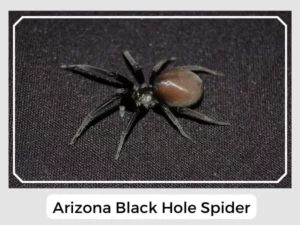Have you ever heard of the Arizona black hole spider? This spider is part of the crevice web spider family and, as you might guess, it lives in Arizona! We’ve gathered some neat facts about this spider, so keep reading to find out more!

Photo Credit: Kevin Lentz
The eggs are loosely wrapped within the silken sac and kept safely inside the funnel-shaped webbing.
After hatching, they stay with their mother for some time before dispersing.
They produce robust and adhesive webbing around crevices or cracks.
Yes, Arizona Black Hole Spiders are venomous. They use their venom mainly to catch their food, but it’s not too strong for humans.
Yes, Arizona Black Hole Spiders can bite. They usually like to keep to themselves, but if they do bite, it feels like a small pinch and isn’t harmful to most people.
These spiders play an important role in their desert ecosystem by controlling pest populations. Their predation on common insects like beetles, cockroaches, and houseflies helps to maintain ecological balance. They are nocturnal hunters, often going unnoticed by humans due to their reclusive nature.
Natural Predators: Their natural predators include birds, lizards, and other larger spiders, which are integral to keeping the spider population under control and preventing overpopulation within their ecological niche.
Prey-Predator Dynamics: The Arizona Black Hole Spider’s predatory behavior is a critical element in the desert food chain. While they help regulate insect populations, they also fall prey to a range of desert-adapted species, showcasing the interdependence of desert organisms.
Relationship with Humans: Though venomous, the Arizona Black Hole Spider’s bite is not considered harmful to humans. These spiders are non-aggressive and tend to avoid contact, biting only when provoked and even then, the bite is likened to a small pinch.
| Lifespan | 5-8 years |
| Distribution | The United States, including Arizona, California, Nevada, and New Mexico |
| Habitat | Underneath rocks and in caves |
| Diet | Beetles, cockroaches, and houseflies |
In conclusion, the Arizona Black Hole Spider is an intriguing and beneficial arachnid, contributing to the desert’s biodiversity through its role as an insect predator.
Have you ever heard of the Arizona black hole spider? This spider is part of the crevice web spider family and, as you might guess, it lives in Arizona! We’ve gathered some neat facts about this spider, so keep reading to find out more!

Photo Credit: Kevin Lentz
The eggs are loosely wrapped within the silken sac and kept safely inside the funnel-shaped webbing.
After hatching, they stay with their mother for some time before dispersing.
They produce robust and adhesive webbing around crevices or cracks.
Yes, Arizona Black Hole Spiders are venomous. They use their venom mainly to catch their food, but it’s not too strong for humans.
Yes, Arizona Black Hole Spiders can bite. They usually like to keep to themselves, but if they do bite, it feels like a small pinch and isn’t harmful to most people.
These spiders play an important role in their desert ecosystem by controlling pest populations. Their predation on common insects like beetles, cockroaches, and houseflies helps to maintain ecological balance. They are nocturnal hunters, often going unnoticed by humans due to their reclusive nature.
Natural Predators: Their natural predators include birds, lizards, and other larger spiders, which are integral to keeping the spider population under control and preventing overpopulation within their ecological niche.
Prey-Predator Dynamics: The Arizona Black Hole Spider’s predatory behavior is a critical element in the desert food chain. While they help regulate insect populations, they also fall prey to a range of desert-adapted species, showcasing the interdependence of desert organisms.
Relationship with Humans: Though venomous, the Arizona Black Hole Spider’s bite is not considered harmful to humans. These spiders are non-aggressive and tend to avoid contact, biting only when provoked and even then, the bite is likened to a small pinch.
| Lifespan | 5-8 years |
| Distribution | The United States, including Arizona, California, Nevada, and New Mexico |
| Habitat | Underneath rocks and in caves |
| Diet | Beetles, cockroaches, and houseflies |
In conclusion, the Arizona Black Hole Spider is an intriguing and beneficial arachnid, contributing to the desert’s biodiversity through its role as an insect predator.